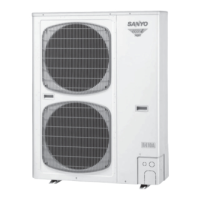Processes and Functions
6
TD831077
VI - 4
2. Protection Controls
Table 7
6 Increase in capacity is allowed
5
Increase in capacity prohibited
2
1.5 Decrease in capacity
Te °C
~
Table 8
X Thermostat off
55 Decrease in capacity
54
Increase in capacity prohibited
50
49 Increase in capacity is allowed
Te °C
~
NOTE
Demand input
Contact 1 Contact 2
Control description
✕✕No limits (100%)
j ✕ 70% of the outdoor unit maximum capacity total
✕ j 50% of the outdoor unit maximum capacity total
jj
Number of outdoor units allowed to operate: 0; The command "3 minute OFF" = ON is sent
to the indoor and outdoor units.
j: Input ✕: No input
Table 9
(3) Coil temperature control
1 Evaporation temperature control
The lowest of the E1, E2, and E3 temperatures of all indoor units whose cooling thermostat is on is designated
as the minimum evaporation temperature (Te), and control is performed as shown in the table 7. This control is
performed every 30 seconds.
¶ If the evaporation temperature is less than 2°C and the thermostat is off, control of the operation capacity at
the next startup may begin from the smallest capacity.
¶ If "test run" is selected for even one indoor unit when the indoor units are running under cooling operation,
the unit is constantly set to "increase in capacity is allowed".
¶ Three minutes after the compressor is started, "decrease in capacity" is regarded as "increase in capacity
prohibited".
¶ When "decrease in capacity" control is activated for the minimum capacity due to the evaporation tempera-
ture, this is handled as "increase in capacity prohibited" for six minutes, and the thermostat is not turned off.
2 Condensation temperature control
The highest of the E1 and E2 temperatures of all indoor units whose heating thermostat is on is designated as
the maximum condensation temperature (Tc), and control is performed as shown in the table 8. This control is
performed every 30 seconds.
The thermostat off temperature X varies from 60°C to 64°C depending on whether operation was stopped by
the protection control or other control mechanisms.
¶ If the condensation temperature becomes more than X°C and the thermostat is off, control of the operation
capacity at the next startup may begin from the smallest capacity.
¶ When "decrease in capacity" control is activated for the minimum capacity due to the evaporation tempera-
ture, this is handled as "increase in capacity prohibited" for six minutes, and the thermostat is not turned off.
¶ If the condensation temperature X°C is reached, the thermostat remains off for at least three minutes.
(4) Demand control

